I’m pretty sure I could live in a perpetual season of Autumn and be perfectly content. The crisp days and rainy nights, the bright colors and cozy flavors. I am crazy about all of it.
While driving home yesterday, I stopped abruptly on the side of the road twice in the span of ten minutes. Each time, my five year-old daughter hollered from the backseat, “Did you forget something, Mama?” Why yes, I did. I forgot about that beautiful row of bright red trees and that farm stand that has perfect pumpkins for two bucks each. We turned the car around and drove back for a phone full of pictures and a trunk full of pumpkins. My kids accept this as normal behavior; they know this is important stuff.
Pumpkins in every shape, size, and color are scattered all over my house as decorations in October, but they aren’t just another pretty face. Pumpkins are also packed with nutrients. One cup of pureed pumpkin is loaded with vitamins A (over 200% of the recommended daily intake!), E, and C. One cup also contains three grams of fiber, over three grams of iron, and only 49 calories!
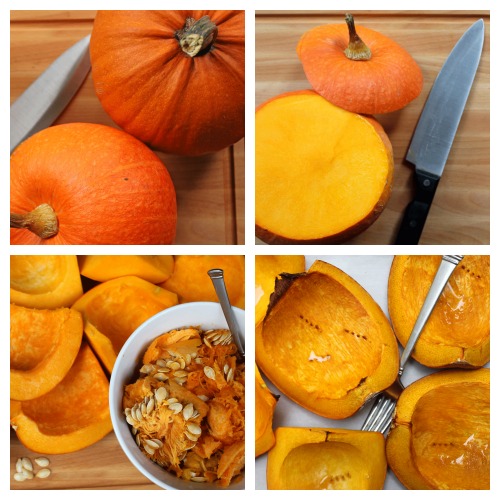
Five years ago, I started making my own pumpkin puree from whole pumpkins. It happened by accident. I was driving along, minding my own business, when a sign at a local farm stand caught my eye, “Free pumpkins!” How do you refuse an offer like that? Ten minutes later, I was driving away with over 30 pumpkins in the back of my car. I had no clue what I was going to do with them.
I had been in baby food making mode, so roasting and pureeing a bunch of pumpkins didn’t seem like that big of a deal. And it really wasn’t. The steps were simple, and the results were great, better than anything I could find in a can. Thirty pumpkins was admittedly a bit nuts. It’s like saying you’d like a drink of water, then turning on a fire hose, but we did eat every last cup of it in baked goods that year. My daughter probably ate her baby weight in straight-up pumpkin puree alone. If she has excellent eyesight, I’m pretty sure we owe it to her heavy vitamin-A intake in the first year of life.
I have been stocking my freezer with pumpkin puree ever since (in normal people quantities now).
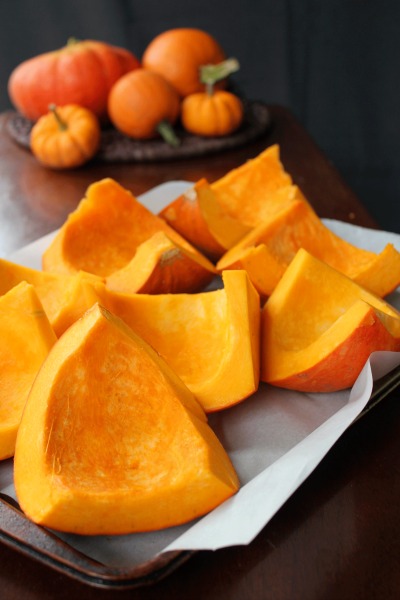
For the best flavor & texture, go with smaller (2-4 pound), sweeter pumpkin varieties, like pie or sugar pumpkins. The two small pumpkins I roasted produced 8 cups of puree. The large jack-o-lantern carving pumpkins would result in a watery, stringy, bland puree.
Keep your eyes open for cheap pumpkins throughout October, but post-Halloween is really the best time. Growers are often looking to unload their leftover pumpkins, sometimes for free. So clear out your trunk and ask your friendly farmer (or produce guy) if he can swing you a good deal.
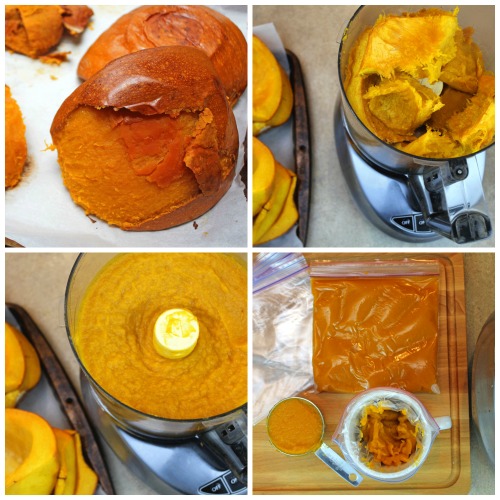
If you haven’t tried roasting and pureeing whole pumpkins yet, this is your year! You could even put kids to work on some of these steps. So grab a pumpkin and let’s get started!
Homemade Pumpkin Puree
Ingredients
2 whole small (2-3 pounds) pumpkins
- Using a sharp knife, cut the stem off each pumpkin, then cut the pumpkins into quarters.
- With a sturdy spoon, scrape out the seeds and pulp from the center of each piece. Place the seeds in a bowl and set aside for later to make roasted pumpkin seeds.
- Place the pumpkin pieces on a rimmed baking sheet and roast in a 350-degree oven for 1 hour (some varieties may take longer), or until the pumpkin is fork-tender. The flesh should be soft and dark and the skins should peel off easily when done.
- Let the pumpkin cool for 10 minutes. Using a spoon or your fingers, peel off the skin from the pumpkin pieces and discard.
- Put a few pumpkin pieces at a time into a food processor or blender. If you use a blender, you may need to add some additional water.
- Blend the pumpkin until smooth. If it looks too dry, add in a few tablespoons of water to give it the right consistency. If the puree is overly watery, you could strain it on cheesecloth or over a fine mesh strainer to get rid of some of the liquid.
- Scrape the pureed pumpkin into a separate bowl, and continue pureeing until all the pumpkin is done. You can either use this immediately in any pumpkin recipe or store it in the freezer for later use.
- To store in the freezer, place a plastic storage bag in a wide mug and spoon 1 cup of pumpkin into each bag. Seal the bag with a small opening remaining, then use your hands to flatten out the pumpkin inside the bag and push out the air. Store the flat bags in the freezer for up to a year.
Use the pumpkin puree to make:
Soft Pumpkin Cookies with Cinnamon Cream Cheese Frosting
Pumpkin Bars with Vanilla Frosting (gluten and dairy-free)
Pumpkin Cake with Maple Cream Cheese Frosting
******************************************************************
If you are looking for a sharp knife at a good price, check out the 8-Inch Victorinox Chef’s Knife (Amazon). The high-carbon stainless-steel blade provides a sharp, sturdy edge that will last. This Victorinox Chef’s Knife has received rave reviews, both on Amazon and from other independent sources.
Looking for more pumpkiny goodness?
Find more frugal homemaking posts here and a list of amazing recipes here.
Follow Frugal Living NW on Pinterest!
Fantastic range of boards from best recipes and tips for frugal living to gardening and budgeting help.
This post may contain affiliate links. See the disclosure policy for more information.
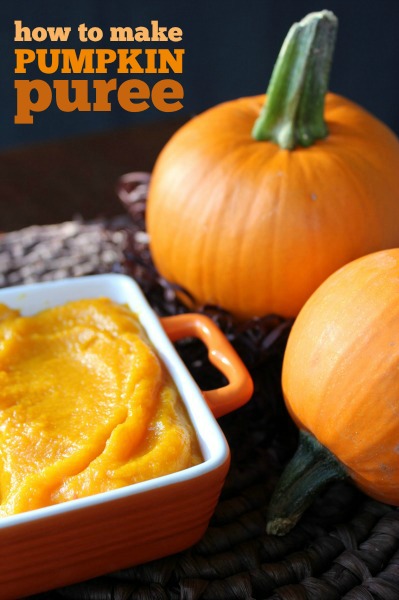


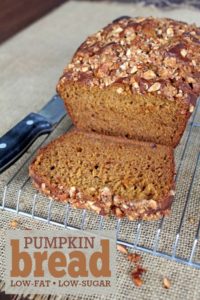
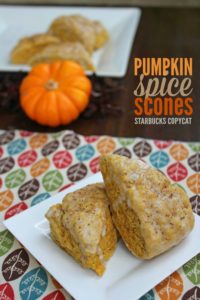
Wouldn’t it just be easier to thrown the pumpkin out of a 5th-story window?
I just made my first batch of puree, tastes great! Taking a break and then I’m going to try your scone receipe! Thank you so much! Another thing I can cross on my bucket list!
Awesome! Great job!
Sounds wonderful, but wouldn’t it be easier to place the pumpkin in your driveway and drive over it? Or drop it off your roof? (I must have been a member of Smashing Pumpkins in a prior lifetime.)
I used to go this method, until I learned that you could roast them whole!! Wash, dry, roast on a cookie sheet or in a casserole dish (I do a couple at a time) for 40-60 mins at 400. When a knife cuts into the pumpkin like butter, pull them out, slice open and let cool. The seeds are much easier to scrape out, and the skin literally peels off…no crazy cutting required.
A note on the seeds. When I made my butternut squash puree, I kept the seeds. When the squash was done in the oven, I turned off the oven (it was at 350-375), laid the seeds out on a cookie sheet, salted them and stuck them in the oven. They heated as the oven cooled. It just seemed to be the right amount of heat. Other recipes say low heat and it never seems to work for me.
Other recipes say low heat and it never seems to work for me.